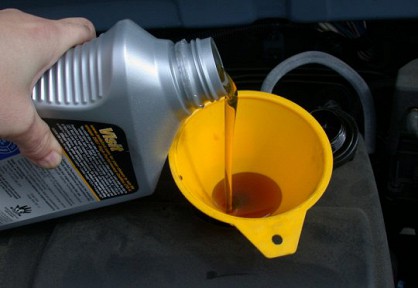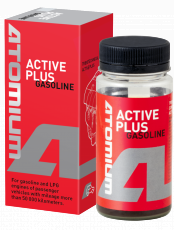 INCREASED OR high oil consumption in the engine is a common case and that is why gains our attention. Firstly car owners wonder what is considered to be excessive or high consumption of oil? Secondly why do we have such increased oil consumption? And the last question: what to do?
INCREASED OR high oil consumption in the engine is a common case and that is why gains our attention. Firstly car owners wonder what is considered to be excessive or high consumption of oil? Secondly why do we have such increased oil consumption? And the last question: what to do?
Let's start from the beginning.
What is considered to be excessive or high engine oil consumption?
For most unforced and medium-forces engines (the ratio of engine power to the working volume is no more than 70 - 75 hp / L) normal engine oil consumption is that figure at which the oil level (during all oil lifecycle) decreases from the top to the bottom of the label probe.
As for highly accelerated engines for general use (not sport engines) in order to keep an acceptable condition they are designed in a way to improve lubrication and provide the heat removal from the key parts of CPG. That is all accompanied by an increased rate of oil consumption. For example, for most of the V6 and V8 engines manufacturer permits oil consumption up to 1 liter per 1000 km. I.e. 10 liters of oil per 10 000 km, which is 1.5 - 2 times higher than the volume of oil in the crankcase. In fact, the manufacturers hedged.
Oil waste is highly dependent on the operating mode. Running the engine at conditions close to nominal followed by fold increased oil consumption. Urban cycle of running with frequent engine braking leads to oil sucking through the valve guides. Therefore, if we run the engine in one of these modes (of mixed), the oil consumption will be 1 L per 1000 km. If you practice more moderate suburban driving the consumption may be 0.1 L per 1000 km.
Why do we have such increased oil consumption?
Large or increased oil consumption occurs for the following reasons:
• Poor quality oil;
• Increased wear of piston assemblies;
• Loss of oil rings mobility;
• Valve stem seals don’t work;
• Defective crankcase ventilation;
• Oil leaks;
• Oil release into the exhaust pipe through the turbine;
• Oil release in the cooling system.
As you see, there are not so many causes, but as a whole, they cover the entire engine.
Poor quality oil can be an obvious fake, i.e. a mixture of mineral oils without additives, or famous brand replacement by cheap commercial product. Also oil may be improperly selected for the particular engine, nearest environment and operating conditions. Typically, the manufacturer gives regional oil applying recommendations and, as a rule, recommends its own brand.
You can use cheaper oil of the same quality, but you have to be sure in the supplier or carry an out oil test.
Range of oil consumption for the good-working engine with oils of different quality can be very broad. But the main thing here is not even oil consumption of oil waste, but the consequences of operating the engine with low-quality oil. Poor quality oil can not only quickly burn out from the walls of the cylinder, but also leave more carbon and lacquer films that come from increased degradation of oil.
Low cleaning and dispersant properties lead to bad dispose of fouling products from the friction zones and increase abrasive wear of friction parts. Low alkali and corrosion resistance leads to intense corrosion wear. As a result, there is a second and third reason for increased oil consumption. And it is all also due to oil waste.
Increased wear of the cylinder group affects the increase of oil consumption, mainly due to the increase of the gap in the piston oil ring groove. Other factors of CPG while maintaining mobility and elasticity of the rings are insignificant. Large gap in the groove is capable of pumping oil as displacement pump. When the piston moves down the ring removes oil and passes under itself. When the piston top ring abuts the lower edge of the groove and pushes oil upwards. Portion of the oil is ready for combustion.
Oil additive for restoring characteristics of gasoline engines of passenger cars with mileage more than 50.000 kilometers. May be used also for CNG and LPG engines.
If the oil combusts intensely and varnishes are not washed off, and are not removed from CPG parts sooner or later, the rings will be coked (carbonized). At the same time, they fail to fulfill their function:
- compression, i.e. stop providing the desired charge of oxidizer in a combustion chamber,
- oil removal, i.e. remove the oil.
Firstly the scraper rings will fail as they are more "oily".
Both of these processes intensification burn oil (wear and coking) cyclically worsen the conditions of the engine work up to the disastrous state, when the engine does not start or the valves burn, or the cylinder parts don’t work.
During operation, valve stem seals (gaskets valves) are exposed to high temperatures, that leads to loss of elasticity. Furthermore, the abrasive particles in the oil (soot from CARBONYL) wear out the sealing surfaces of caps, as well as the guides and valve stems. Thus, the working life of this site is highly dependent on the mode of operation (engine overheating) and the quality of the oil (anti-wear and abrasion).
Any crankcase ventilation system, regardless of the structure must provide acceptable concentration of the exhaust fumes broken through the housing in order to protect the oil from oxidation and contamination, and reducing the pressure in the crankcase in order to prevent extrusion of the seal oil through. By definition, oil vapor moves out with the crankcase gases, the concentration of which depends on the temperature of the oil, that is on the mode of operation of the engine and on oil cooling efficiency.
Oil vapors stay on oil impingement plates and flow back into the crankcase. During continuous engine operation, when the oil is dirty and gases break into the crankcase, the surface of oil impingement plates gradually becomes contaminated with a mixture of products of incomplete combustion, carbon deposits, elements of oil destruction of and other precipitation. Despite the increase of the gas flow and oil vapor, with a reduction in the flow cross section, efficiency "rebound" of the oil decreases. This is due to the fact that the principle of the oil release is in a sharp reversal of flow barriers on the sharp edges, and they get dirty in the first place. Furthermore, the pressure in the crankcase increases, resulting in the expulsion of oil through non densities.
This is another reason for the increased oil consumption, but this one is not associated with oil waste. More often non-densities are formed in stuffing boxes due to their poor quality, wear (dirty oil), improper installation and overheating. There can be also oil leakage through the gaskets when they lose their properties and improper tightening, when hitting the crankcase, with tightness locations of the sensors and other causes. But all the non-densities are mainly manifested when pressure increases in the crankcase, with the exception of seal failure in the cylinder head on the block.
Oil emission into the exhaust pipe through the turbine happens if oil seals fail in the turbocharger. Then the oil, which passes to this turbocharger under pressure as a lubricant for the bearing starts to flow into the exhaust pipe and, of course, burns, or just flies out of the pipe. Life of this oil seal is also dependent on its initial quality modes (temperature) and the quality of the oil.
Oil emission into the cooling system can occur if part of the gasket is broken in that area which is located between the working cylinder and the holes of the cooling system. The reasons for that may be poor quality gasket, improper tightening or discrepancy planes cylinder head and block.
What to do at the Excessive oil consumption?
For our convenience let’s summarize the cause, the diagnosis and the consequences of major oil consumption in the table.
№ | Cause | Consequence | Diagnosis | What to do? |
| 1 | Poor-quality oil | Increased oil waste (burn); | Carbon deposits on the cover of the oil - neck; | Replace the improper oil and use one appropriate to the engine type and mode of operation; |
| 2 | Increased wear of cylinder piston group | Increased pumping of the oil by scraper ring; | Blue smoke on the drive with the load or permanently (except for diesel engines); | Restore technical condition following ATOMIUM technology; |
| 3 | Loss of oil rings mobility | Increased pumping of the oil by scraper ring; | Blue smoke on the drive with the load or permanently (except for diesel engines); | Use ATOMUIM Motor Flush Process the engine according to ATOMIUM technology |
| 4 | Inoperative valve seals | Increased oil waste (burn); | Blue smoke at high revving, then on the 5th – 10th revving the blue smoke disappears (except for diesel); | Replace the valve seals; |
| 5 | Defective crankcase ventilation system | Increased oil waste (burn); | Carbon deposits on the cover of the neck; | Apply flushing of the crankcase ventilation system. |
| 6 | Oil leakage through the non-densities | Increased oil consumption; | Test on paper - 20 minutes - not a single drop; | Figure out the cause of increased pressure of the gases in the crankcase (see p.2, p.5); |
| 7 | Oil emission into the exhaust pipe through the turbine | Increased oil consumption; | Emission of oil droplets from the exhaust pipe when the engine is cold (test paper on a section of pipe); | Replace the oil seals; |
| 8 | Emission of oil into the cooling system | Increased oil consumption; | Oiling of the coolant (turbidity, color change); | Repair the engine. |
Increased oil consumption. How ATOMIUM can help?
Extra excessive oil consumption happens when piston housing is burned or broken, but these things need no comments. Engine repairs, treated by ATOMIUM would cost "a little blood" in such cases, as the cylinders (shells) and the bearings are not affected.
In diesel engines blue smoke from the pipe with the smell of oil and fuel can occur when the cylinder doesn’t work. Then the oil flow is increased too. This happens most often due to faulty fuel injection equipment. Such failures can be improved with ATOMIUM technology, when Atomium is added to the lubricating oil for compression recovery, and/or to the diesel fuel for the recovery of fuel pumps.

